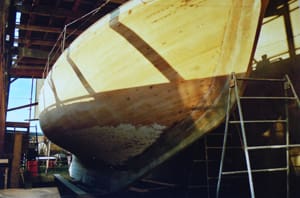To the editor: “Not possible! In one day? If you think you are going to do that, I want to be there.” So Mick, a professional boatbuilder, joined 19 other friends at 8 a.m. one autumn morning to put two layers of 650-gram, double-bias cloth onto the upright hull of our full-keel, 43-foot wooden ketch Windora. Originally built with a single layer of 6-ounce cloth in epoxy, it was now, 30 years later, showing some wear and tear. Because we were intending to do high-latitude cruising, the structural layup would give better protection.
Leading up to this day, I had spent 200 hours removing the original glass with a 180-mm grinder. There is a bit of skill required to do this well, in order to avoid getting flat spots and grooves ground into the hull. The lead ballast was freshly ground that morning to give good adhesion.
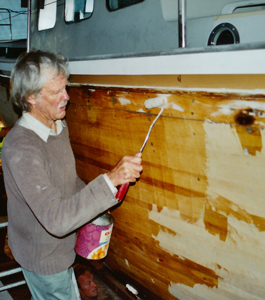 |
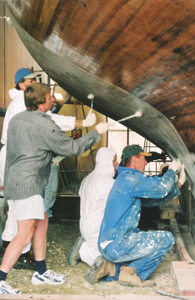 |
|
|
Left, using rollers to wet out the bare hull with resin before the cloth is applied. The volunteer work crew rolls on the resin to a vertical length of fabric, right. |
||
I chose to mix the 200 liters of resin needed to wet out the 200 kilograms of cloth myself, five liters at a time, to ensure quality control. With 10 men on each side, the work began. A huge diesel blast heater had been running for three hours to warm the hull so the resin would be absorbed into the cooling timber. The whole hull was coated in resin using nook-and-cranny rollers and then, starting each side amidships, the first vertical drops were put on. The cloth had been pre-cut and put onto cardboard rolls for ease of use. By starting amidships, the four teams of five guys could work simultaneously, going forward and aft both sides. The laps were between 20 and 30 mm. A cut was made down the joins with a Stanley knife, and the two pieces removed; this produced a perfect butt.
It was barely two hours later that we were all enjoying a hot drink and some home baking.
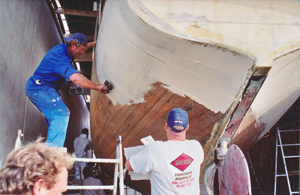 |
|
The crew applying a coat of microballoons. Phil Christieson later longboarded the hull to prepare for the layers of bottom paint. |
The second layer was horizontal, starting from the gunnel and working down in order to get the first lap below the waterline since it couldn’t be cut. It was a bit more awkward to handle the long lengths, but by now the guys knew what they were doing and it all went really smoothly. The laps were ground the next day while the epoxy was still green.
By lunchtime, the two layers were on. Unbelievably, it had been done in less than four hours! No one had believed it would happen so quickly. Mick was amazed! More important, it had made what could have been a huge job into an enjoyable morning of male companionship and fun. We fired up the barbecue and brought out the beers, celebrating fours hours of work well done. Leading up to this day, I had helped many of these friends with their own boat projects, telling them that one day I would need their help — and they had all turned up. In fact, such was the interest, I had to turn some people away.
At 3 p.m., Ronnie, a really talented plasterer by trade, turned up to help. A handful of guys applied the microballoons to the topsides ahead of Ronnie and he followed, ensuring a very even and smooth coat.
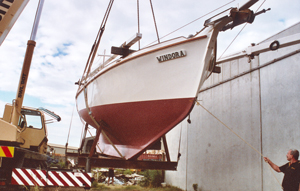 |
|
The ketch after the glassing job and hull painting were finished. |
Then the hard work started for me. Six weeks of longboarding followed, and I learned why it was known as a torture board when used alone. I had chosen a cooler time of the year to do the glassing so the hull wouldn’t become too dry and cause the wood to split. Thank goodness, as this job would have been unbearable in the heat.
Was it worth the effort? Definitely. Cruising in high latitudes can be hard on a wooden boat, and this added protection has been a real plus when mucking about among ice and rocks.
—Phil and Lynda Christieson have owned and voyaged extensively aboard their wooden ketch Windora for 26 years.

